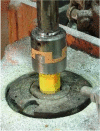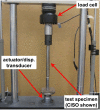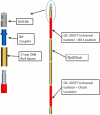Development of elastomeric isolators to reduce roof bolting machine drilling noise
- PMID: 26568650
- PMCID: PMC4642732
- DOI: 10.3397/1.3659660
Development of elastomeric isolators to reduce roof bolting machine drilling noise
Abstract
Among underground coal miners, hearing loss remains one of the most common occupational illnesses. In response to this problem, the National Institute for Occupational Safety and Health (NIOSH) Office of Mine Safety and Health Research (OMSHR) conducts research to reduce the noise emission of underground coal-mining equipment, an example of which is a roof bolting machine. Field studies show that, on average, drilling noise is the most significant contributor to a roof bolting machine operator's noise exposure. NIOSH OMSHR has determined that the drill steel and chuck are the dominant sources of drilling noise. NIOSH OMSHR, Corry Rubber Corporation, and Kennametal, Inc. have developed a bit isolator that breaks the steel-to-steel link between the drill bit and drill steel and a chuck isolator that breaks the mechanical connection between the drill steel and the chuck, thus reducing the noise radiated by the drill steel and chuck, and the noise exposure of the roof bolter operator. This paper documents the evolution of the bit isolator and chuck isolator including various alternative designs which may enhance performance. Laboratory testing confirms that production bit and chuck isolators reduce the A-weighted sound level generated during drilling by 3.7 to 6.6 dB. Finally, this paper summarizes results of a finite element analysis used to explore the key parameters of the drill bit isolator and chuck isolator to understand the impact these parameters have on noise.
Figures

































References
-
- 1996. National Institute for Occupational Safety and Health, National Occupational Agenda, Department of Health and Human Services Publication No. 96-115.
-
- Title 30 CFR Part 62, 2000–2005, U.S. Department of Labor, Mine Safety and Health Administration, Information Resource Center.
-
- Peterson Jeffrey Shawn, Alcorn Lynn. Results of noise measurements from underground testing of a roof bolting machine duty cycle. NoiseCon07. 2007
-
- Hawkes I, Burks JA. Investigation of Noise and Vibration in Percussive Drill Rods. Int. J. Rock, Mech, Min. Sci. & Geomech. 1979;16:363–376.
-
- Carlvik I. The Generation of Bending Vibrations in Drill Rods. Int. J. Rock, Mech, Min. Sci. & Geomech. 1981;18:167–172.
Grants and funding
LinkOut - more resources
Full Text Sources
Miscellaneous
